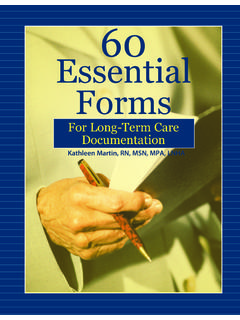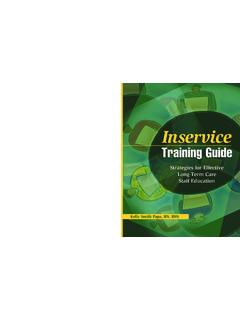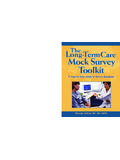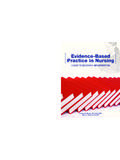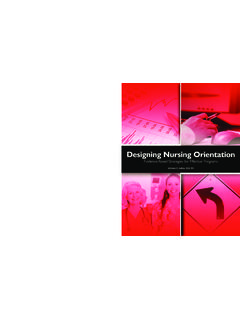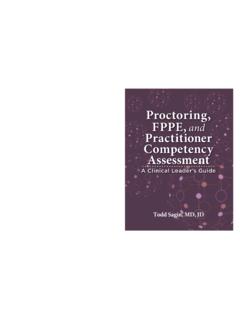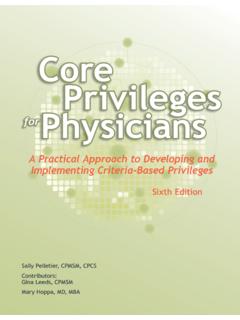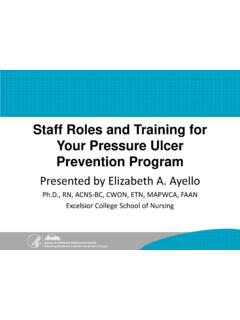Transcription of Long-Term Care Pocket Guide to
1 Long-Term CareLong-Term CarePocket Guide toNursingDocumentationNursingDocumentati onContentsSection I: The medical record ..1 Item I-1: The medical record ..3 Item I-2: Resident s name and medical record number ..5 Item I-3: Month, day, year, time ..6 Item I-4: Signatures ..10 Item I-5: Initials ..12 Item I-6: Rubber stamp signatures ..14 Item I-7: Fax signatures ..15 Item I-8: Faxed records ..16 Item I-9: Legible, ink entries ..17 Item I-10: Do not skip lines ..20 Item I-11: All fields/blocks are to be filled ..22 Item I-12: Language of the medical record ..23 Item I-13: Acceptable abbreviations ..25 Item I-14: Entries consistent with the rest of the medical record ..26 Item I-15: Change in the resident s condition ..28 Item I-16: Informed consent ..29 Item I-17: Note/discharge summary ..30 Item I-18: Notification ..32 Item I-19: Charge nurse responsibilities.
2 33 Item I-20: Incident reporting ..34 Item I-21: Factual and objective information ..35 Item I-22: Narrative charting and summaries ..36 Item I-23: Admission/readmission narrative note ..37 Item I-24: Content of narrative charting ..38 Item I-25: Monthly summary charting ..39 Item I-26: Medicare documentation ..41 Item I-27: Skilled nursing/therapy charting ..42 Item I-28: Therapy treatment time ..43 Item I-29: Omissions in documentation ..44 Item I-30: Omissions on medication/treatment records, graphic, and other flow sheets ..48 Item I-31: Documenting care provided by another nurse ..50 Item I-32: Resident amendments to the medical record ..52 Item I-33: Proper error correction procedure ..55 Section II: Resident assessments and other related documents ..57 Item II-1: Admission record ..59 Item II-2: Assessments ..60 Item II-3: Types of assessments.
3 62 Item II-4: Preadmission assessment ..63 Item II-5: Admission assessment ..65 Item II-6: Fall assessment (F324) ..66 Item II-7: Skin assessment (F314) ..68 Item II-8: Bowel and bladder assessment (F316) ..69 Item II-9: Physical restraint assessment (F221) ..70 Item II-10: Self-administration of medication (F176) ..72 Item II-11: Nutrition assessment (F325) ..73 Item II-12: Activities/recreation/leisure interest assessments (F248) ..74 Item II-13: Social services (F250) ..75 Item II-14: Mental and psychosocial functioning (F319, F320) ..77 Item II-15: Restorative/rehab nursing assessment (F317) ..78 Section III: Other types of medical documentation .. 79 Item III-1: Pharmacy drug review (F428) ..81 Item III-2: Antipsychotic drug therapy (F330) ..82 Item III-3: Dose reduction schedules and documentation (F331) ..83 Item III-4: Medication and treatment records.
4 85 Item III-5: Flow sheets/flow records ..86 Item III-6: Lab and special reports (F504, F505, F511, F510) ..87 Item III-7: Consents, acknowledgements, and notices ..89 Item III-8: Consent, notice, and authorization to use/release medical records (F164) ..90 Item III-9: Notice of bed-hold policy and readmission (F205) ..91 Item III-10: Notice of legal rights and services (F156) ..92 Item III-11: Notice before transfer (F203) ..93 Item III-12: Notice prior to change of room or roommate (F247) ..94 Item III-13: Advance directives (F155-156) ..95 Item III-14: DNR order v. advance directives ..96 Item III-15: Discharge documentation (F202) ..97 Item III-16: Discharge summary (F283, F284) ..98 Item III-17: Physician s discharge summary v. discharge record ..100 Section IV: Physician documentation ..101 Item IV-1: Physician progress notes (F386) ..103 Item IV-2: Dictated progress notes.
5 105 Item IV-3: Nurse practitioner and physician assistant documentation ..106 Item IV-4: History and physical ..107 Item IV-5: Other professional consultation records/notes .108 Item IV-6: Documenting the resident s diagnoses ..109 Item IV-7: Physician orders ..112 Item IV-8: Content of an order ..113 Item IV-9: Physician order recaps/renewals ..116 Item IV-10: Fax orders (F386) ..117 Item IV-11: Standing-order policies ..118 Item IV-12: Authentication/obtaining signatures ..119 Item IV-13: Transcription of orders and noting orders ..120 Item IV-14: Contacting the physician to obtain an order ..121 Item IV-15: Discontinuing an order when a new order is obtained ..123 Item IV-16: Updating/changing physician order recaps/renewals after they have been signed ..124 Item IV-17: Processing physician orders after hospitalization resume previous orders ..125 Item IV-18: Verification of hospital orders with attending physician.
6 126 Item IV-19: Accepting orders from an NP or PA ..127 Item IV-20: Accepting orders from specialists or consultants ..128 Section IThe MedicalRecord3 Section I: The Medical RecordItem I-1: The medical recordThe resident s medical record (commonly referred to as the chart ) is used by all members of the healthcare team tocommunicate the resident s progress and the current treat-ment. It provides a record of the resident s health status,including observations, measurements, history, and progno-sis, and serves as the legal document describing the health- care services provided to the resident. The chart also is usedto determine the appropriateness and quality of care by describing the services provided to the resident providing evidence that the care was necessary documenting the resident s response to the care andchanges made to the plan of care identifying the standards by which care was deliveredThe chart also provides supporting documentation for the reimbursement of services provided to the resident a source of data for clinical, health services, and outcomes research, as well as public health purposes a major resource for healthcare practitioner educa-tion, the legal business record for a healthcare organ-ization, and support for business decision-makingIItem I-1: The medical record4 documentation Do s: Who charts in the medical record?
7 Section I: The Medical RecordItem I-1: The medical recordIAnyone who documents in the medical record shouldbe credentialed/have the authority and right to docu-ment as defined by facility page of the medical record or computerized recordscreen must show the resident s name and medical recordnumber. This includes both sides of the pages, every shin-gled form, computerized print out, etc. When double-sided forms are used, the resident s nameand medical record number must be on both sides becauseinformation is often copied and must be kept with the cor-rect data for that resident. Section I: The Medical RecordItem I-2: Resident s name and medical record numberItem I-2: Resident s name and medical record number6 Include the month, day, year, and time of each event orobservation with every medical record entry. Include thetime in all types of narrative notes even though it may notseem important to the type of entry.
8 Item I-3: Month, day, year, timeISection I: The Medical RecordItem I-3: Month, day, year, time7 IDocumentation don ts:Time blocksDo not chart time as a block ( , 7 3), especially fornarrative notes. Narrative documentation should reflectthe actual time the entry was made. For certain types of flow sheets, such as a treatmentrecord, recording time as a block could be accept-able. For example, a treatment that can be deliveredany time during a shift could have a block of time iden-tified on the treatment record with staff signing that theydelivered the treatment during that I: The Medical RecordItem I-3: Month, day, year, time8 Indicate the date and time of completion as well as whohas completed each section of assessment forms wheremultiple individuals are completing the entries as soon as possible after an event or observa-tion is made. Section I: The Medical RecordItem I-3: Month, day, year, timeI9 documentation don ts: Advanced entries and pre- and back-datingDo not make entries in advance.
9 Pre-dating or back-dating an entry is both unethical and illegal. Entriesmust be dated with the actual date and time the entryis made. Section I: The Medical RecordItem I-3: Month, day, year, timeIIf it is necessary to summarize events that occurred overa period of time (such as a shift), the notation shouldindicate the actual time the entry was made with the nar-rative documentation identifying the time at which the relevant events occurred. 10 Every entry in the medical record must be signed by theperson making the entry. This includes all types of entries,such as narrative/progress notes, assessments, flow sheets,orders, etc., whether in paper or electronic format. What to includeAt minimum, the signature should include the first initial,last name, and there are two people with the same first initial and lastname, both must use their full signatures (and/or middleinitial, if applicable).CountersignaturesCountersign atures should be used as required by state law ( , a graduate nurse who is not licensed, a therapy assistant, etc.)
10 The person who is making the counter-signature must be qualified to countersign. For example, a licensed nurse who does not have the authority to super-vise should not be countersigning an entry for a graduatenurse who is not yet I: The Medical RecordItem I-4: SignaturesItem I-4: SignaturesI11 Federal regulations for Long-Term care (LTC) do not requirecountersignatures for nurse practitioners and physicianassistants, but state licensure and professional practice reg-ulations may govern I: The Medical RecordItem I-4: SignaturesI12 Section I: The Medical RecordItem I-5: InitialsItem I-5: InitialsIAny time a facility chooses to use initials in any part of therecord for authentication of an entry, there has to be cor-responding full identification of the initials on the sameform or on a signature person who documents with initials in the medical record must have a corresponding full signature on record.
